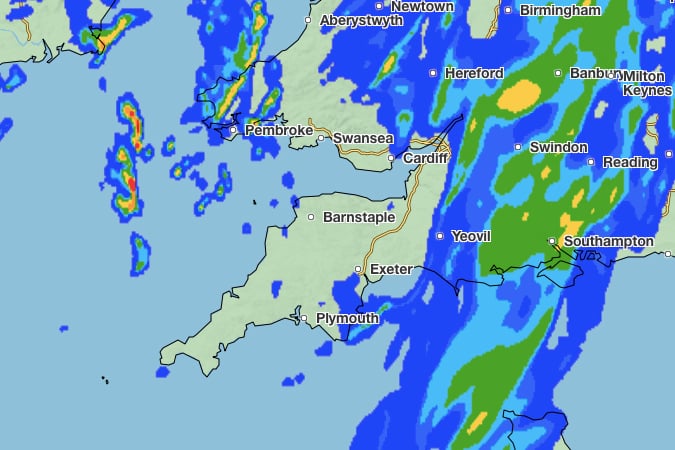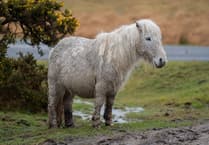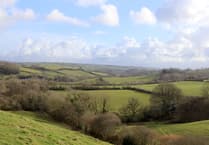MOTORISTS are advised to travel with care in the Crediton area after a number of trees were brought down by strong winds.
At Higher Road, Crediton, a tree was brought down across the Roa at about lunchtime today, Wednesday, December 27. Fortunately it moved by some motorists who found their way blocked.
Also about the same time, the road between the main village of Whitestone and Heath Cross saw a large tree come down.
At this time the road is still blocked pending removal of the tree.
A tree also came down in Thorverton but has been removed.
A tree is currently blocking the A377 near Lapford, further details as we have them.
The Met Office says that unsettled weather with heavy rain and strong winds is set to continue until New Year’s Day, Sunday, December 31.
The forecast for the rest of today, Wednesday, December 27 is for a wet and windy day with outbreaks of rain sweeping across the region, turning heavier at times through the afternoon before gradually easing. Winds staying strong with the risk of coastal gales but on the mild side. Maximum temperature 13 °C.
Tonight:
Some clear spells at first followed by blustery heavy showers, merging to give longer spells of rain and carrying the risk of hail. Staying windy, with coastal gales. Remaining mild. Minimum temperature 7 °C.
Thursday:
Staying unsettled with frequent heavy showers, merging at times to give longer spells of rain and perhaps the risk of hail. Remaining windy especially over the hills and coasts. Maximum temperature 12 °C.
Outlook for Friday to Sunday:
Brighter spells and a few showers on Friday with winds easing. Turning cloudier and breezier on Saturday with rain arriving later followed by showers and sunny spells on Sunday.
Flood alerts have been issued for the River Dart and Upper Tamar areas by the Environment Agency.
TRAVEL WARNING
Insurer and road safety campaigner NFU Mutual is urging drivers to take extra care as they travel during the next few days.
An expected spike in traffic as people visit friends and family and return home over Christmas coincides today with Storm Gerrit, which will bring rain and could batter parts of the country with 70mph gusts.
The conditions will make driving more treacherous than usual, reducing visibility, increasing stopping distances and affecting drivers' control of their vehicle, as well as increasing the risk of debris on the roads.
As a campaigner for rural road safety, NFU Mutual is urging motorists to be particularly careful on dangerous rural roads.
The leading rural insurer's recent analysis of Department for Transport data found that there are 72 per cent more deaths on countryside roads than urban roads, also finding in a survey that over a fifth of people are uncomfortable using rural roads.
Andrew Chalk, rural road safety specialist at NFU Mutual, said: “We campaign for rural road safety because we know these highways are singificantly more deadly than urban roads, bringing unique hazards which require a greater level of care and attention than other, less dangerous roads.
"The rain and high wind brought by Storm Gerrit will hot most of the United Kingdom and will only increase the common hazards like mud and debris on the road, reduced visibility of corners and junctions, uneven road surfaces and narrow roads. Coupled with the fact many people will be using rural roads at this time of year who may not be used to them, we're concerned that this Christmas period could be marred by unwelcome injuries and fatalities.
"Don't take unnecessary risks in this weather - make sure you're well rested and take your time when driving, avoid the roads unless you need to use them and pay attention for other road users and hazards such as uneven road surfaces, blind corners and junctions and mud and other hazards. Getting home or to family a few minutes earlier is not worth a potentially life-changing accident."
NFU Mutual has produced guidance for all those using rural roads as part of its rural road safety campaign: Rural Road Safety | NFU Mutual.
Some things for motorists to look out for are:
Speed limits, not targets – designated speed limits are provided as a maximum legal guide, however, hazards such as sharps bends, animals on the road and changing conditions often mean that drivers should determine their speed by the circumstances, rather than the speed limit.
Winding roads – when driving on twisting roads, slow your car ahead of the bend to a speed which will allow you to stop should a hazard emerge around the corner. Braking as you enter a bend will likely mean that you are going too fast and are not in full control of your vehicle. Look ahead and use tree lines, telegraph poles and hedges to determine where the road is going.
Mud on the road – the prevalence of farm vehicles on rural roads inevitably means that there will sometimes be mud from the fields left on the road. Mud, along with wet leaves, can be incredibly slippery in wet conditions; you should exercise caution and reduce your speed.
Manure on the road – anyone driving on a rural road should expect to share it with horses and their riders. Spotting a fresh pile of manure should alert you to the possibility that horses are not far away. Drivers should slow down and be prepared to stop if necessary.
Limited vision – hedges and overgrown trees can make it difficult to clearly see the road ahead. This difficulty is increased in fairer weather, when there may be more ramblers, runners, horse riders and cyclists using the roads. Assess your speed according to your surroundings.
Reacting to wildlife – look out for signs that indicate you may encounter wildlife. If you do, your natural instinct might be to swerve to avoid a rabbit or pheasant, but this is dangerous and could cause a serious collision due to losing control of your vehicle. Larger animals present a bigger problem. If there’s no oncoming traffic then sounding your horn may startle the animal to move safely out of the way, whilst braking could reduce the severity of an impact, but always be mindful of vehicles behind you.
Livestock delays – farmers often need to use the roads to move livestock such as cattle, horses and sheep to and from their fields, usually at dawn and at the end of the day. If the road is blocked by livestock the best thing to do is stop the car, turn off your engine and wait patiently.
Farm traffic – tractors and farm machinery on the road can be frustrating for drivers caught up in a queue. However, usually a tractor will not be travelling too far up the road, so it won’t be long before the road is clear again. If you do decide to overtake, make absolutely sure the road ahead is clear and consider any junctions ahead that motorists may pull out from. Due to their size, tractors might swing out to the right before turning left, be aware of this before making the decision to overtake.
Ice on or under bridges – the road surface on bridges will be the first to freeze when the temperate drops, whilst roads that run underneath them will often be the last to thaw. Consider your speed and stopping distance in icy conditions.
Churches are a sign – if you see a church spire in the distance, it’s very likely that you’re about to drive into a residential area, so be prepared to reduce your speed and look out for vulnerable road users – especially children.




